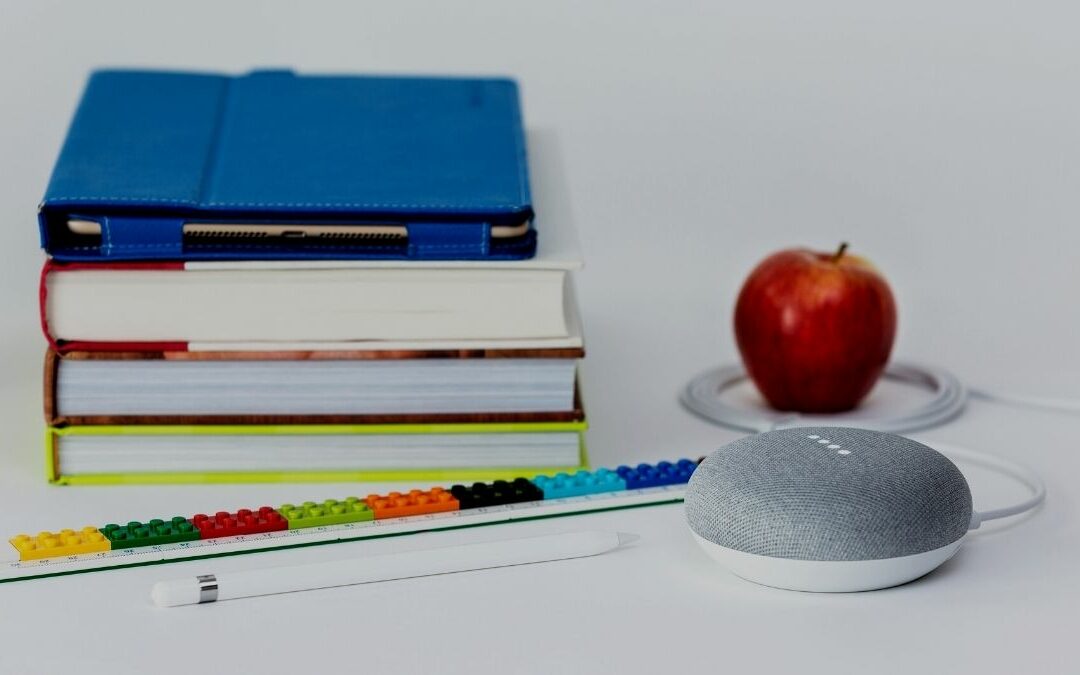Strong and effective communication is a true mark of leadership and a well-organized institution. As a school administrator, communication use-cases range from staff reporting to sending notices to parents. There are a multitude of considerations, and the task can get overwhelming– yet an effective solution is quite simple: creating a school communication plan.
Let’s look at the different types of school communication and how you can plan them effectively.
Types of school communication you must plan for
As a school administrator responsible for systematic communication, you have to accommodate and adjust for the convenience and preferences of three recipient categories—staff members, students and parents.
The different types and use-cases of school communication you must plan for include:
- Regular updates and notifications to parents: These include reminders or notices about planned events, school closing days, and other planned announcements.
- Internal communication (among staff members): Say a teacher is off and requires someone to substitute. The conversation must be two-way (sending the request and someone volunteering). An organized school communication system can streamline this without the teachers having to find informal ways to communicate.
- Admin-to-staff communication: Communication that is one way, from top to bottom, must be planned so that all staffers are informed simultaneously.
- Notices and updates to students: In-house announcements are usually made over the speaker system. But what about notices before and after school timings? Effective communication in schools also considers such scenarios.
- Emergency alerts: Alerts are messages that must reach a large group of people simultaneously. These can include last-minute school closing warnings, weather alerts or emergency notifications of mishaps.
How do we communicate in schools?
Let’s look at the standard communication channels to staff, parents, and students and why they are effective.
Online methods
Online communication methods are convenient, user-friendly and in high demand. It is not easy to imagine our world without the internet. How are schools adapting their communication online? Here are four common ways:
- Website
Many private and public schools invest in a website since 93% of online experiences begin with a search. An SEO friendly, up-to-date and visually appealing school website can bring traffic for searches such as best high school in x location. The school website typically aims to:
- Provide information to current students, staff and parents.
- Attract new students.
81% of parents prefer email communication for school information. Emails also provide space for lengthy content and media attachments.
The strengths of emails lie in communication, where documentation, signatures and other formalities are essential. Of course, they are equally useful for lengthy communication types such as newsletters.
Here’s a school email announcing a coding course for students:
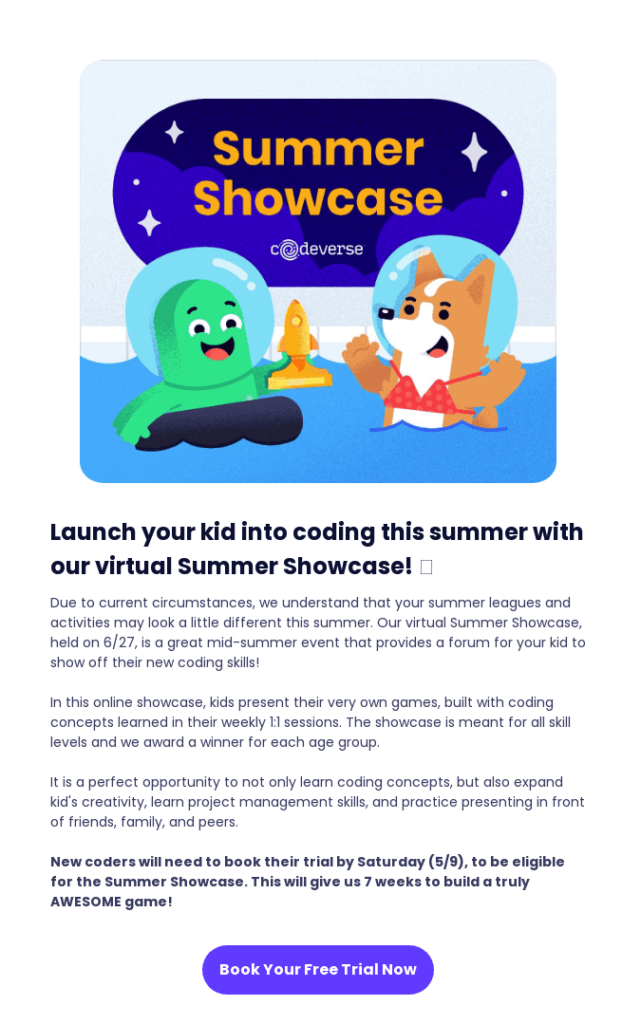
- Social media
90% of individuals between the ages of 13-17 have used social media. Many have active profiles on channels like Facebook, Instagram, YouTube, Snapchat and Twitter. For schools who want to communicate with their students, adopting a social media communication strategy is advisable since they are active on these platforms.
Offline methods
Although these are more traditional communication methods, they are still highly relevant and practical. Offline methods can be greatly personal and personalized, making school communication an intimate and valued experience. Here’s how schools adopt them:
- Texts
For time-sensitive updates, 71% of K-12 parents prefer texts. 90% of texts are opened within the first three seconds of receiving it. No doubt then that text messages are an effective channel for school communication.
- Calls
Typically reserved for communication between the school and parents/guardians, phone calls enable personal communication between the two parties.
Schools usually reserve phone calls to convey bad news to parents. However, research shows that schools can strengthen the relationship with parents by extending this communication method for neutral conversations and good news.
- Meetings
The last year has seen most schools shifting their teaching methods online. This has drastically changed pupils’ relationships with their school. While traditionally reserved for special circumstances, meetings are now more critical to strengthen the bond between students, teachers, parents and the school.
In normal circumstances, too, meetings allow better connections between parents, students and school staff members. PTA meetings and parent-student-teacher meetings are thus a way to keep the conversation flowing beyond the classroom.
- School notice boards
A classic way of communicating notices and announcements to students, the school notice board still remains a much-used form of communication. However, two obstacles make it ineffective:
- Redundancy when your school has moved to online classes.
- No way of getting accurate data on how many have read the notice.
Some schools have transferred these notice boards online, but that simply means they have reserved space on their website or social media for notices and announcements.
As an administrator heading the school’s communications, you must map out each channel intelligently for the use-cases mentioned above. Let’s look at best practices and strategies for creating a school communication plan that encompasses it all.
How do you strategize a school communication plan?
Effective communication strategies in education involve knowing the success rate of commonly adopted channels and practices. This can be through trial and error, by conducting a survey or asking recipients to choose from available options. The resulting information can help you increase students’, parents’ and staffs’ involvement in the school through a well-strategized plan.
Here are some effective strategies to help build your school communication plan.
Adopt a multi-channel approach for internal school communication
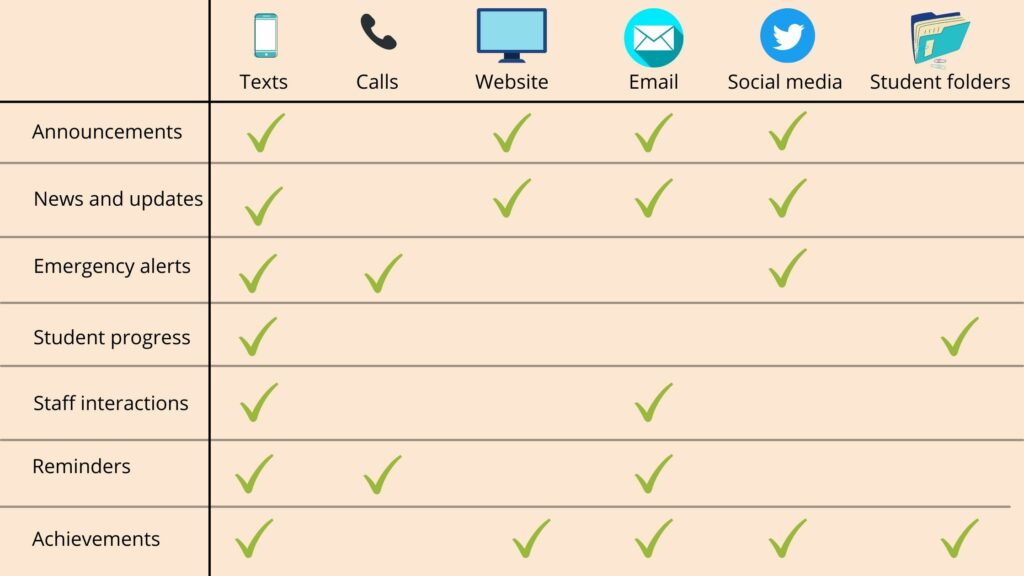
Internal communication for schools involves communication within staff members, administration and staff, and students. By adopting a multi-channel approach here, you increase the chances of an important announcement, notice or update reaching the desired audience.
We have listed commonly used offline and online communication methods for schools above. If your current methods are not working to your expectations, consider experimenting with high-success and convenience-driven channels like text messaging and email.
Schools must note that “convenience” here translates to how likely your end-user is to use the communication channel. For instance, if they don’t check social media regularly, your posts on them will not fulfil the objective.
Consider what parents want
If you plan out communications with parents and guardians, your objective is likely higher parental involvement in school activities and processes. It is crucial to consider parental preferences in such cases because schools risk low engagement from parents without it.
It is hard to gauge from afar what channels parents want and what messages they want to be communicated. The most efficient way to understand their needs and preferences is to conduct a survey via text, emails or other common forms of communication and ask how they would like to be contacted in the future. You could also ask for their preferences during your next face-to-face meeting.
But, overall, studies say this;
Parents prefer receiving school news via:
- Email from the district or school.
- Text messages.
- Online portals for parents.
- E-newsletters from the district or school.
- School or district website.
- Telephone or voice messaging services.
What they want to know from schools:
- Updates on the ward’s progress and ways to improve performance.
- Timely warnings if performance is falling.
- Information on what the child is expected to learn in the year.
- Homework and grading process and policies.
Maintain a fair consistency and frequency of communication
Research shows that frequent family-teacher communication can increase homework completion rate by 54% and attendance rate by 15%. Thus, your school communication plan must account for consistency and regularity in touching base with parents.
This includes dry spells where no notices or updates are to be sent. While it’s fair enough to pause all communication in such times, these open windows provide an opportunity to indulge in communication that is not time-sensitive but can nurture your audience.
Scheduled phone calls with parents are an excellent way to maintain the consistency of communication with parents. While calls are traditionally reserved in schools for bad news, this need not be the case. Calls are personal and allow long open-ended conversations.
If you plan on continuing online classes for the foreseeable future, calls give an added benefit. They maintain personal interaction with the school authorities while most processes have become distant and impersonal. A 5-10 minute interaction can bring parents up to speed with the ward’s performance, your plans for the classes and other such updates that parents want. The calls can be from the admin or from teachers.
If you are a school with a large student population, you may want to consider investing in a call centre tool designed for educational institutions. This tool can fast track the process of dialling numbers and consolidate all existing and newly acquired information in one place. Try it for free here.
Plan for meetings and conferences with parents
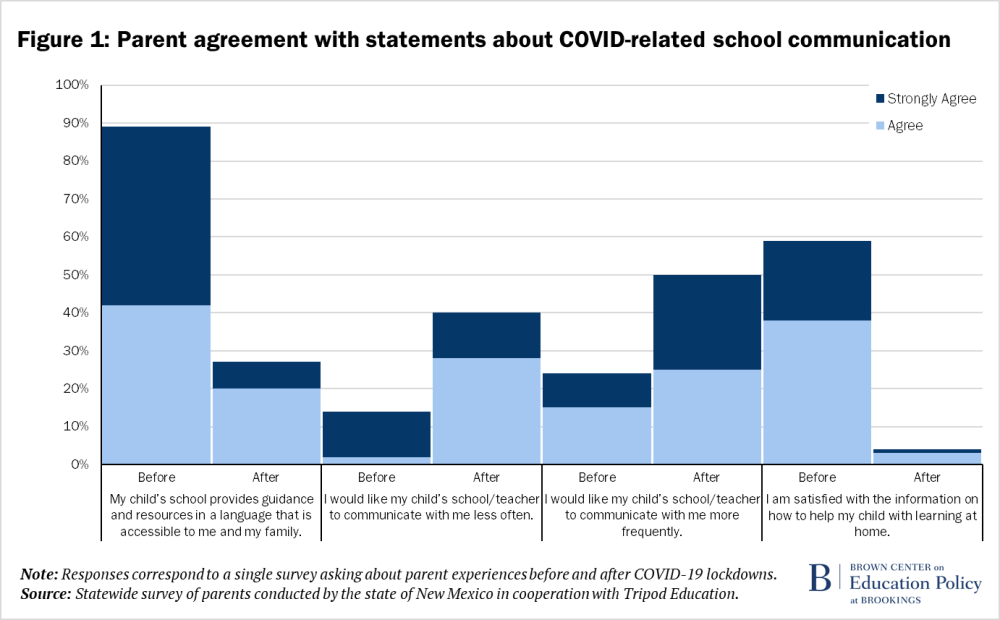
Parent-teacher meetings and conferences have always been a must in school activities. It gives a sense of belonging to the parents, helps bring them up to speed with the class progress and also helps in networking. A one-on-one meeting typically lasts around 30 minutes, while a class-wise conference can go up to an hour.
Creating a school communication plan involves accounting for one-on-one (admin-to-someone) and one-to-many (admin-to-many) interactions.
Make sure you organize at least one parent-teacher conference every school term. The talking points can be:
- Elaboration on report cards.
- A child’s strengths and weaknesses.
- Their academic, sports, cultural and social performances.
- The school’s plan for the next term.
Send home newsletters and student folder
If you feel that one parent-teacher conference per term doesn’t do justice to conveying student progress but parents are not too keen on attending more, there’s an excellent middle ground to adopt. Newsletters and student folders serve the purpose of consolidating the school’s future plans and student performance.
Traditionally, newsletters and folders were sent home on physical paper. But since most of your data is now online, you can simply send a text to parents with a link to the folder and a summary of what’s new.
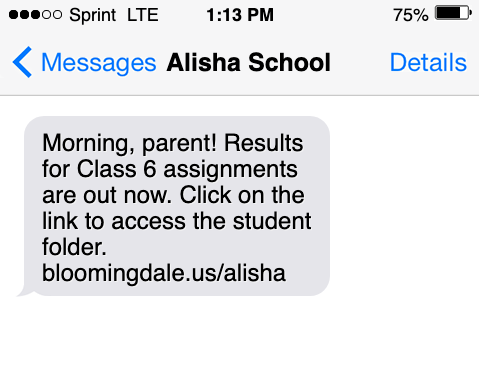
Here’s what the two school communication methods typically contain:
| Newsletters | Student Folders |
| – Event news and summary – Class progress – Future plans – Student achievements School achievements – News and updates | – Academic performance – Report cards – Participation in extracurricular activities – Attendance – Other remarks |
Use texts for emergency alerts
Consider these statistics:
- 71% of parents want schools to send texts for time-sensitive news.
- Texts have a 98% open rate.
- Most texts are opened within three seconds of receiving them.
Text alerts are an efficient way to reach parents, students or staff members in time. Your school communication plan must involve a strategy to leverage this channel for quick and convenient updates.
A text marketing software with mass texting tools can make the process quicker. You upload the list of contacts (option to segment them by class, relationship with school etc.) in advance. When the time arises to send the emergency text,
- Log in to your software and select relevant contact lists.
- Add a draft on the software.
- Personalize with merge tags (e.g., first name or class) if required.
- Send.
Related Reading: Emergency Text Alerts: How to Send Urgent Updates in Times of Crisis
Use online communication channels only for non-urgent notifications
While your website and social media profiles are excellent ways to update your online presence, they are not necessarily efficient methods for one-on-one communication. This is a crucial point to note when planning your content.
Here are the ideal content types for online communication channels like the school website and social media:
| School website | Social media |
| – Information about events – Academic results – Star student boards – Non-academic and non-urgent updates (e.g., personal achievements) – School information – Information about staff members and alumni | – Buzz around events (before giving updates on personal channels). – Event updates – Special and personal achievements – Photos and videos of past events – Community building (e.g., with page followers) |
To conclude:
A school communication plan is ideally carefully mapped and organized, keeping the needs of your students, parents and staff in mind. For personal communication, both texts and calls have shown their efficacy time and again. Especially in the current times, when personal contact with students and meetings with parents has become rare, these personal communication channels have become more critical.
If you are looking for communication software that eases the process of texting and calling, why not try CallHub? We have designed our tools for educational institution needs. Click on the below links to try us for free:
Feature image source: Thomas Kolnowski/Unsplash.

